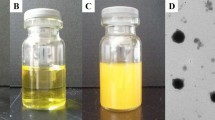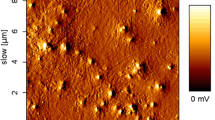Abstract
To enhance the bioavailability of protein therapeutants and improve the stability of storage and delivery, a series of branched amphiphilic block copolymers consisting of cholic acid (CA) initiated poly(D,L-lactide-co-glycolide) (CA-PLGA) and water-soluble polyethyleneimine cross-linked polyethylene glycol (PEI-PEG) denoted as CA-PLGA-b-(PEI-PEG) were synthesized and characterized. CA-PLGA-b-(PEI-PEG) presented low cytotoxicity by MTT and cck-8 assay. The cationic CA-PLGA-b-(PEI-PEG) micelles (diameter about 100 nm and zeta potential 34–61 mV) were prepared through self-assembly method, and complexed with insulin via electrostatic interaction to obtain nanoscale micelle/insulin complexes. The micelle/insulin complexes-loaded CA-PLGA microspheres (MIC-MS, 10.4 ± 3.85 μm) were manufactured by employing a double emulsion (W1/O/W2) method. The in vitro insulin release behavior and in vivo hypoglycaemic effect of MIC-MS on streptozotocin (STZ) induced diabetic rats were compared with those of the insulin-loaded CA-PLGA microspheres (INS-MS, 7.8 ± 2.57 μm). The initial burst in vitro release of MIC-MS was markedly lower than that of INS-MS (P < 0.01), and the pharmacological availability of MIC-MS via subcutaneous administration was 148.9% relative to INS-MS. Therefore, the cationic CA-PLGA-b-(PEI-PEG) micelles can effectively increase the bioavailability of insulin in CA-PLGA microspheres and can be considered as a potential protein carrier.










Similar content being viewed by others
References
Zheng C, Zhang XG, Sun L, Zhang ZP, Li CX. Biodegradable and redox-responsive chitosan/poly(l-aspartic acid) submicron capsules for transmucosal delivery of proteins and peptides. J Mater Sci Mater Med. 2013;24:931–9.
Begarani F, Cassano D, Margheritis E, Marotta R, Cardarelli F, Voliani V. Silica-based nanoparticles for protein encapsulation and delivery. Nanomaterials. 2018;8:886.
Lim H-P, Tey B-T, Chan E-S. Particle designs for the stabilization and controlled-delivery of protein drugs by biopolymers: a case study on insulin. J Control Release. 2014;186:11–21.
Lale SV, Gill HS. Pollen grains as a novel microcarrier for oral delivery of proteins. Int J Pharm. 2018;552:352–9.
Leader B, Baca QJ, Golan DE. Protein therapeutics: a summary and pharmacological classification. Nat Rev Drug Discov. 2008;7:21–39.
Ye Y, Yu J, Wen D, Kahkoska AR, Gu Z. Polymeric microneedles for transdermal protein delivery. Adv Drug Del Rev. 2018;127:106–18.
Lee KY, Yuk SH. Polymeric protein delivery systems. Prog Polym Sci. 2007;32:669–97.
Villegas MR, Baeza A, Vallet-Regi M. Nanotechnological strategies for protein delivery. Molecules. 2018;23:1008. https://doi.org/10.3390/molecules23051008.
Guo H, Guo Q, Chu T, Zhang X, Wu Z, Yu D. Glucose-sensitive polyelectrolyte nanocapsules based on layer-by-layer technique for protein drug delivery. J Mater Sci Mater Med. 2014;25:121–9.
Peng Q, Zhang Z-R, Gong T, Chen G-Q, Sun X. A rapid-acting, long-acting insulin formulation based on a phospholipid complex loaded PHBHHx nanoparticles. Biomaterials. 2012;33:1583–8.
Taluja A, Youn YS, Bae YH. Novel approaches in microparticulate PLGA delivery systems encapsulating proteins. J Mater Chem. 2007;17:4002–14.
Mukhopadhyay P, Mishra R, Rana D, Kundu PP. Strategies for effective oral insulin delivery with modified chitosan nanoparticles: a review. Prog Polym Sci. 2012;37:1457–75.
Alai MS, Lin WJ, Pingale SS. Application of polymeric nanoparticles and micelles in insulin oral delivery. J Food Drug Anal. 2015;23:351–8.
Wong CY, Al-Salami H, Dass CR. Microparticles, microcapsules and microspheres: a review of recent developments and prospects for oral delivery of insulin. Int J Pharm. 2018;537:223–44.
Ansary RH, Rahman MM, Mohamad N, Arrif TM, Latif AZA, H Katas L, et al. Controlled release of lysozyme from double-walled poly(lactide-co-glycolide) (PLGA) microspheres. Polymers. 2017;9:485. https://doi.org/10.3390/polym9100485.
Mir M, Ahmed N, Rehman Au. Recent applications of PLGA based nanostructures in drug delivery. Colloids Surf B Biointerfaces. 2017;159:217–31.
MM Pakulska, IE Donaghue, JM Obermeyer, A Tuladhar, CK McLaughlin, TN Shendruk, et al. Encapsulation-free controlled release: electrostatic adsorption eliminates the need for protein encapsulation in PLGA nanoparticles. Sci Adv. 2016;2:e1600519. https://doi.org/10.1126/sciadv.1600519.
Abdul Hamid ZA, Tham CY, Ahmad Z. Preparation and optimization of surface-engineered poly(lactic acid) microspheres as a drug delivery device. J Mater Sci. 2018;53:4745–58.
Wu JZ, Williams GR, Li HY, Wang DX, Li SD, Zhu LM. Insulin-loaded PLGA microspheres for glucose-responsive release. Drug Deliv. 2017;24:1513–25.
Guarecuco R, Lu J, McHugh KJ, Norman JJ, Thapa LS, Lydon E, et al. Immunogenicity of pulsatile-release PLGA microspheres for single-injection vaccination. Vaccine. 2018;36:3161–8.
PW Lee, JK Pokorski. Poly(lactic-co-glycolic acid) devices: production and applications for sustained protein delivery. Wiley Interdiscip Rev: Nanomed Nanobiotechnol. 2018;10:e1516. https://doi.org/10.1002/wnan.516.
Ayoub MM, Elantouny NG, El-Nahas HM, Ghazy FE-DS. Injectable PLGA Adefovir microspheres; the way for long term therapy of chronic hepatitis-B. Eur J Pharm Sci. 2018;118:24–31.
Kim JR, Netravali AN. Parametric study of protein-encapsulated microcapsule formation and effect on self-healing efficiency of ‘green’ soy protein resin. J Mater Sci. 2017;52:3028–47.
Park W, Kim D, Kang HC, Bae YH, Na K. Multi-arm histidine copolymer for controlled release of insulin from poly(lactide-co-glycolide) microsphere. Biomaterials. 2012;33:8848–57.
Kang HC, Lee JE, Bae YH. Nanoscaled buffering zone of charged (PLGA)(n)-b-bPEI micelles in acidic microclimate for potential protein delivery application. J Control Release. 2012;160:440–50.
Aragón J, Salerno S, De Bartolo L, Irusta S, Mendoza G. Polymeric electrospun scaffolds for bone morphogenetic protein 2 delivery in bone tissue engineering. J Colloid Interface Sci. 2018;531:126–37.
Zhang Y, Lin L, Liu L, Liu F, Maruyama A, Tian H, et al. Ionic-crosslinked polysaccharide/PEI/DNA nanoparticles for stabilized gene delivery. Carbohydr Polym. 2018;201:246–56.
Huang F-W, Wang H-Y, Li C, Wang H-F, Sun Y-X, Feng J, et al. PEGylated PEI-based biodegradable polymers as non-viral gene vectors. Acta Biomater. 2010;6:4285–95.
Lv J, Yang J, Hao X, Ren X, Feng Y, Zhang W. Biodegradable PEI modified complex micelles as gene carriers with tunable gene transfection efficiency for ECs. J Mater Chem B. 2016;4:997–1008.
Ahn C-H, Chae SY, Bae YH, Kim SW. Biodegradable poly(ethylenimine) for plasmid DNA delivery. J Control Release. 2002;80:273–82.
Park MR, Han KO, Han IK, Cho MH, Nah JW, Choi YJ, et al. Degradable polyethylenimine-alt-poly(ethylene glycol) copolymers as novel gene carriers. J Control Release. 2005;105:367–80.
Zeng X, Tao W, Mei L, Huang L, Tan C, Feng S-S. Cholic acid-functionalized nanoparticles of star-shaped PLGA-vitamin E TPGS copolymer for docetaxel delivery to cervical cancer. Biomaterials. 2013;34:6058–67.
Zou T, Cheng S-X, Zhang X-Z, Zhuo R-X. Novel cholic acid functionalized star oligo/poly(DL-lactide)s for biomedical applications. J Biomed Mater Res B Appl Biomater. 2007;82B:400–7.
Chen Y, Yang Z, Liu C, Wang C, Zhao S, Yang J, et al. Synthesis, characterization, and evaluation of paclitaxel loaded in six-arm star-shaped poly(lactic-co-glycolic acid). Int J Nanomed. 2013;8:4315–26.
Zhou M, Zhang X, Xie J, Qi R, Lu H, Leporatti S, et al. pH-Sensitive poly(β-amino ester)s nanocarriers facilitate the inhibition of drug resistance in breast cancer cells. Nanomaterials. 2018;8:952.
Cheng H, Li C, Jiang Y, Wang B, Wang F, Mao Z, et al. Facile preparation of polysaccharide-based sponges and their potential application in wound dressing. J Mater Chem B. 2018;6:634–40.
Liu X, Shen X, Sun X, Peng Y, Li R, Yun P, et al. Biocompatibility evaluation of self-assembled micelles prepared from poly(lactide-co-glycolide)-poly(ethylene glycol) diblock copolymers. Polym Adv Technol. 2018;29:205–15.
Kang HC, Kang H-J, Bae YH. A reducible polycationic gene vector derived from thiolated low molecular weight branched polyethyleneimine linked by 2-iminothiolane. Biomaterials. 2011;32:1193–203.
Ou M, Xu R, Kim SH, Bull DA, Kim SW. A family of bioreducible poly(disulfide amine)s for gene delivery. Biomaterials. 2009;30:5804–14.
Su F-Y, Lin K-J, Sonaje K, Wey S-P, Yen T-C, Ho Y-C, et al. Protease inhibition and absorption enhancement by functional nanoparticles for effective oral insulin delivery. Biomaterials. 2012;33:2801–11.
Sharma G, Wilson K, van der Walle CF, Sattar N, Petrie JR, Kumar MNVR. Microemulsions for oral delivery of insulin: Design, development and evaluation in streptozotocin induced diabetic rats. Eur J Pharm Biopharm. 2010;76:159–69.
Chou H-S, Larsson M, Hsiao M-H, Chen Y-C, Röding M, Nydén M, et al. Injectable insulin-lysozyme-loaded nanogels with enzymatically-controlled degradation and release for basal insulin treatment: In vitro characterization and in vivo observation. J Control Release. 2016;224:33–42.
Peng Q, Sun X, Gong T, Wu CY, Zhang T, Tan J, et al. Injectable and biodegradable thermosensitive hydrogels loaded with PHBHHx nanoparticles for the sustained and controlled release of insulin. Acta Biomater. 2013;9:5063–9.
Tang GP, Zeng JM, Gao SJ, Ma YX, Shi L, Li Y, et al. Polyethylene glycol modified polyethylenimine for improved CNS gene transfer: effects of PEGylation extent. Biomaterials. 2003;24:2351–62.
Tao W, Zeng X, Liu T, Wang Z, Xiong Q, Ouyang C, et al. Docetaxel-loaded nanoparticles based on star-shaped mannitol-core PLGA-TPGS diblock copolymer for breast cancer therapy. Acta Biomater. 2013;9:8910–20.
Zhang C, Wang W, Liu T, Wu Y, Guo H, Wang P, et al. Doxorubicin-loaded glycyrrhetinic acid-modified alginate nanoparticles for liver tumor chemotherapy. Biomaterials. 2012;33:2187–96.
Herrera Estrada LP, Champion JA. Protein nanoparticles for therapeutic protein delivery. Biomater Sci. 2015;3:787–99.
Wu Q, Wang C, Zhang D, Song X, Liu D, Wang L, et al. Synthesis and micellization of a new amphiphilic star-shaped poly(D,L-lactide)/polyphosphoester block copolymer. React Funct Polym. 2012;72:372–7.
Giteau A, Venier-Julienne MC, Aubert-Pouëssel A, Benoit JP. How to achieve sustained and complete protein release from PLGA-based microparticles? Int J Pharm. 2008;350:14–26.
Wan Y, Yu A, Wu H, Wang Z, Wen D. Porous-conductive chitosan scaffolds for tissue engineering II. In vitro and in vivo degradation. J Mater Sci Mater Med. 2005;16:1017–28.
Acknowledgements
This work was funded by the National Natural Science Foundation of China (No. 81373365) and Guangdong Science and Technology Project (No. 2015A010105014).
Author information
Authors and Affiliations
Corresponding author
Ethics declarations
Conflict of interest
The authors declare that they have no conflict of interest.
Additional information
Publisher’s note: Springer Nature remains neutral with regard to jurisdictional claims in published maps and institutional affiliations.
Supporting information
Rights and permissions
About this article
Cite this article
Wang, J., Li, S., Chen, T. et al. Nanoscale cationic micelles of amphiphilic copolymers based on star-shaped PLGA and PEI cross-linked PEG for protein delivery application. J Mater Sci: Mater Med 30, 93 (2019). https://doi.org/10.1007/s10856-019-6294-y
Received:
Accepted:
Published:
DOI: https://doi.org/10.1007/s10856-019-6294-y




